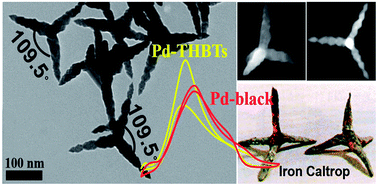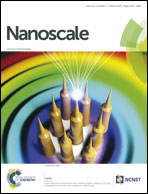Multi-generation overgrowth induced synthesis of three-dimensional highly branched palladium tetrapods and their electrocatalytic activity for formic acid oxidation†
Abstract
Highly branched noble metal nanostructures are highly attractive for catalytic applications owing to their specific physical and chemical properties. In this work, three-dimensional highly branched palladium tetrapods (Pd-THBTs) have been constructed in the presence of polyvinylpyrrolidone (PVP) through one-step hydrothermal reduction of ethylenediamine-tetramethylene phosphonate–palladium(II) (EDTMP–PdII) by formaldehyde. The morphology and structure of the Pd-THBTs were fully characterized and the growth mechanism was explored and discussed based on the experimental observation. The concave Pd tetrahedra grew into highly branched Pd tetrapods consisting of four nanothorn-like branches with tetrahedral dimensions through interesting multi-generation nanocrystal overgrowth. The electrocatalytic activities of the as-synthesized Pd-THBTs toward formic acid oxidation were also studied by cyclic voltammetry and chronoamperometry. The Pd-THBTs showed higher catalytic activity and stability for formic acid oxidation than the commercial Pd black.


 Please wait while we load your content...
Please wait while we load your content...